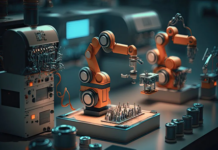
In recent years, the impact of robotics on our lives has significantly increased. It could be an assistant responsible for cleaning and mopping the floor, an educator who engages with children to provide instruction, or even a robotic pet that joins us in daily activities like playtime and shopping. As robots become increasingly available to the general population, the implementation of robot technology in global industrial production have reached a highly developed stage.
More than six decades have passed since the inception of the world’s first industrial robot in the United States in 1959. During this period, robot technology has progressed from a mechanical arm designed for cargo transportation to a sophisticated ‘brain’ that can efficiently oversee and perform tasks in various industries..
At present, a new phase of evolution is unfolding before us, wherein intelligent robots with advanced decision-making capabilities, and a range of new flexible and multi-robot systems, are making their presence felt in the market.
What is an Intelligent Robot?
The latest robotics and automation are equipped with sophisticated control systems, have a perception, and possess human-like intelligent decision-making capacity. With high-performance Micro-Electromechanical Systems (MEMSs), such as accelerometers, pressure sensors, and Inertia Measurement Units (IMUs)allow for the real time feedback from movement systems ensures operations are carried out accurately, safely, and efficiently.
The fundamental distinction between intelligent and traditional robots lies in the fact that traditional robots are limited to execute and operate tasks assigned through programming. Whereas, intelligent robots possess their own assessments regarding the environment and tasks, encompassing cognitive processes such as logical analysis and comprehension of elements. These intellectual activities arise from information processing executed by diverse control systems.
As the demand for complex robotics implementations and advanced decision-making increases, there is a noticeable growth in intelligent robots. Solutions that operate beyond simple repetitive operations are backed by powerful processors and Artificial Intelligence (AI) to enhance their ability to operate ‘off script’.
What is a Soft Robot?
Robots are often associated with their metal construction and rigid appearance. However, in recent times, the demand for soft or flexible designs has increased considerably.
Soft robots, or flexible robots, are fabricated using highly pliable materials and have increased flexibility, deformability, and energy absorption characteristics. These robots are inspired by the biomechanics of living organisms such as worms or invertebrates like octopuses. By imitating the characteristics of the flexible movement of living organisms, these robots can perform tasks in space constraints or high movement applications.
Compared to traditional robots, soft robots are equipped with arrays of sensors across their joints that allow them to have high-precision and higher dynamic movement. The concept of high dynamic movement concerns a robot’s maximum range of motion and its ability to accurately imitate the control of human arm joints and muscles while also autonomously adapting to uncertain environmental conditions. By integrating flexible electronics, flexible robots can emulate the supple nature of the human body. Additionally, when coupled with AI technology, they can harness sensory capabilities such as vision, sound, and force perception to make intelligent decision..
Technical Challenges of Flexible Robots
For robots to exhibit traits such as high flexibility, deformability, and energy absorption, the manufacturing and production of these robots must overcome several technical challenges.
To achieve functional characteristics like being ‘soft and boneless,’ the material composition and driving methods cannot rely on the rigid joints and shell material manufacturing construction used in traditional robots. When considering a material that offers the infinite softness and effortless deformability, it is essential to ensure that its implementation does not compromise the robot’s stability.
The research team at the Massachusetts Institute of Technology (MIT)has performed an extensive range of experiments on the casing of flexible robots[1] (Figure 2). Here’s an example of a successful experiment.

By employing 3D printing and laser cutting techniques, a hydrogel shell was successfully generated, enabling a soft-bodied framework. This robot allowed for the safe and gentle capture of jellyfish without injury to the creature.
Another key technical issue is how to drive a flexible robot. Electric drive and pneumatic drive are two frequently employed methods at present. In terms of its characteristics, the electric-driven movement is both lightweight and compact, with a wide deformation range and a low price. Nevertheless, this drive method encounters challenges in controlling motion accuracy.
The second type of pneumatic drive is often too slow compared to electric and will limit the movement of a flexible robot. Alternative drives have been seen in research applications, and Harvard University has successfully developed a flexible octopus robot that achieves movement by using a simple chemical reaction of hydrogen peroxide (Figure 3).

Application Scenarios of Flexible Robots
Flexible robots can find their applications in various areas. For instance, flexible robots can be employed in disaster recovery efforts when buildings are damaged and human-operated rescue operations are impractical. These robots can navigate dangerous and cramped areas, relying on their flexibility and deformability to assess and assist rescue operations according to the surrounding on-site environment.
Flexible robots can be used in the exploration of the underwater world. Deep-sea exploration has been incredibly hard due to the nature of the environment. But with advancement of flexible robots, this process has become a lot more easier. Like wise, flexible robots canbe used in new methods of surgical operation.
The global flexible robot market was worth approximately US$1.05 billion in 2020 and is expected to reach US$6.37 billion by 2026.. This growth represents a predicted Compound Annual Growth Rate (CAGR) of 35.17% from 2021 to 2026.
What is a Multi-Robot System?
A multi-robot system refers to a group of robots composed of multiple automation robots that can interact with each other. A multi-robot system has greater flexibility and adaptability across highly distributed spaces than a single robot. In addition, the production efficiency and work-carrying capacity are better than that of a single robot, with reliability enhanced through less reliance on a single system.
Collaborative Robot Control System
The control system of collaborative robots is generally divided into one of three categories: centralised control, distributed control, and hybrid control.
In a centralised control system, a main control unit manages the global information and allocates resources and operations to each robot in the group.
The centralised management makes deployment relatively simple and system management convenient, but there can be pitfalls. In more complex systems, a main control unit’s ability and speed to process informationmay be significantly weakened, resulting in reduced efficiency.
Also, if the main controller fails, the entire system will be paralysed. Therefore, centralised controllers typically handle simple tasks and smaller groups of robots.
. A distributed control system does not have a central control unit. Instead, information is exchanged between each robot. The robots then interact, exchange real-time information, and plan autonomous routes.
The advantage of a distributed control system is that it is highly flexible and can increase the number of group robots at any time. However, since there is no central control system, there is the possibility of conflicts due to information interaction time differences and complexities around the collaboration between robots.
To solve the problems existing in the above two systems, hybrid control systems are often deployed.
A hybrid control f system effectively leverage the advantages and strengths of centralised and distributed systems to improve work efficiency. In this system, each robot manages and undertakes its individual tasks, but the central system controls the hierarchy and overall management of operations.
l
Path planning in multi-robot co-operation is not only the path positioning and guidance, but more importantly, the mutual co-operation and co-ordination among the robots, and the ability of the system to function as an efficient and intelligent “hive”.
Locational, perception, and communication solutions, such as GPS, image, radar sensors, Wi-Fi, and Bluetooth modules allow robots to undertake their operational paths without conflict.
Flexible and Multi-Robot Applications
At present, multi-machine collaborative control systems are widely used in manufacturing, retail warehousing, medical pharmaceuticals, agriculture, the military, and other fields.
For example, in the manufacturing industry, whether it is factories for automobiles, electronic home appliances, or non-electronic products such as furniture or clothing, the high precision and speed of collaborative multi-robots improve the processing efficiency and accuracy..
Within distribution applications, multi-robot systems can help improve the speed and safety of warehousing logistics. For example, Amazon deploys an extensive range of robots ranging from Automated Guided Vehicles (AGVs), Autonomous Mobile Robots (AMRs), palletizers, and Automated Storage and Retrieval Systems (AS/RS). These robots work together as well as alongside humans to provide the level of operational efficiency demanded by Amazon’s business model.
In medical applications, flexible robots and multi-robot systems can achieve high-precision and controlled repetitive work. In pharmaceutical research and development, they can help significantly reduce error rates in research, testing, labelling, and packaging.
In the agricultural field, greenhouse growers can use flexible robots in collaboration with automated equipment to perform highly precise and repetitive work, such as picking delicate plants and planting small seeds.
Conclusion
Several human inventions and creations are inspired by nature. Whether it’s the birth of the first robotic arm, a flexible robot resembling a brute, or a multi-robot system inspired by the swarming nature of creatures. We can learn the basic principles from the biological world and apply them in various robot technologies.
Robotics and automation are already playing a key role in manufacturing and distribution, as well as in medical and consumer applications. As we progress, intelligent, flexible, and more sophisticated multi-robot solutions underpinned by AI and arrays of advanced sensors and communication systems would fulfil greater range of applications capable of revolutionising new areas of our work and life.
References
[1] – https://www.science.org/doi/10.1126/scirobotics.aax5425


















